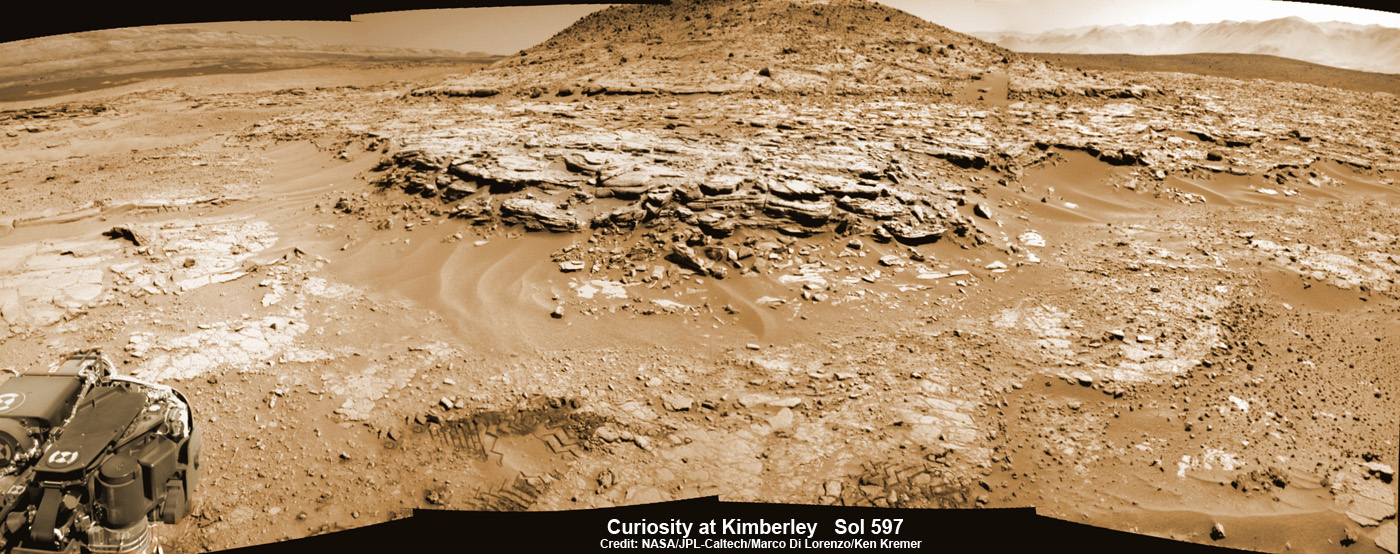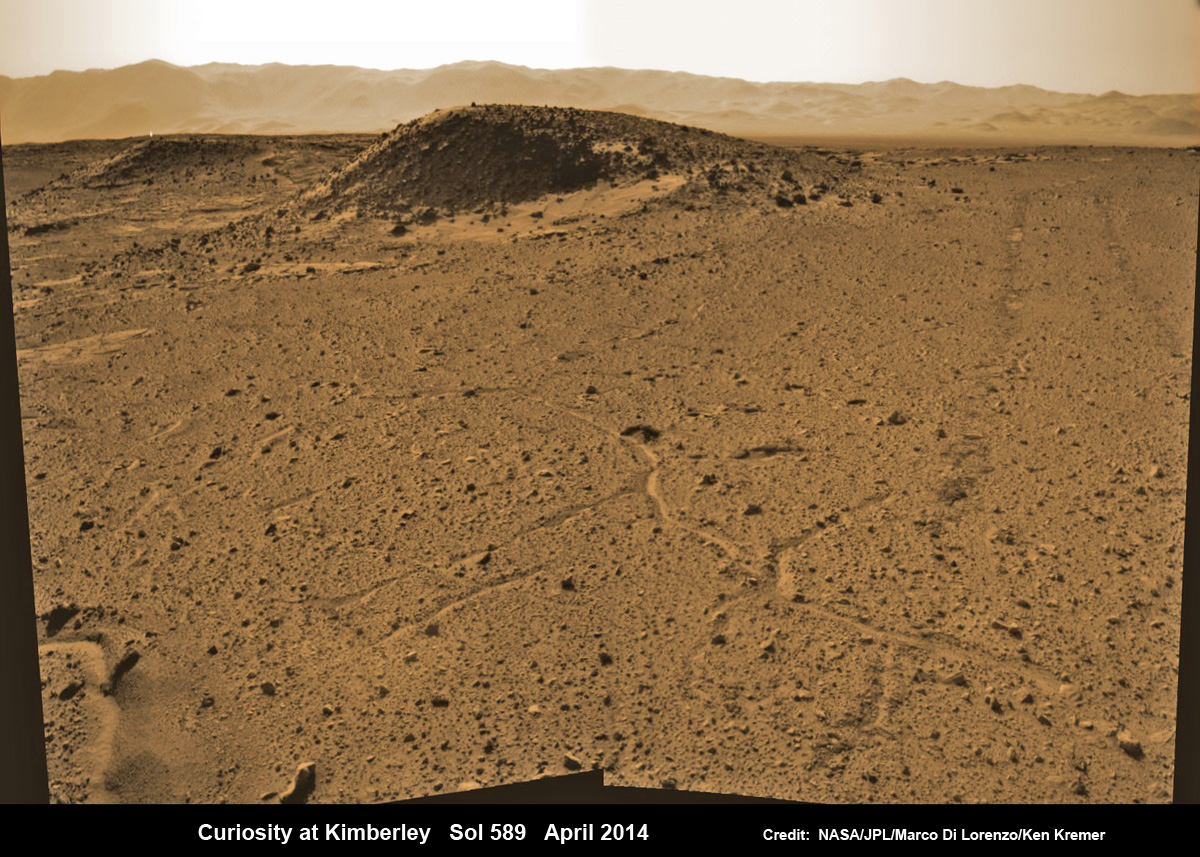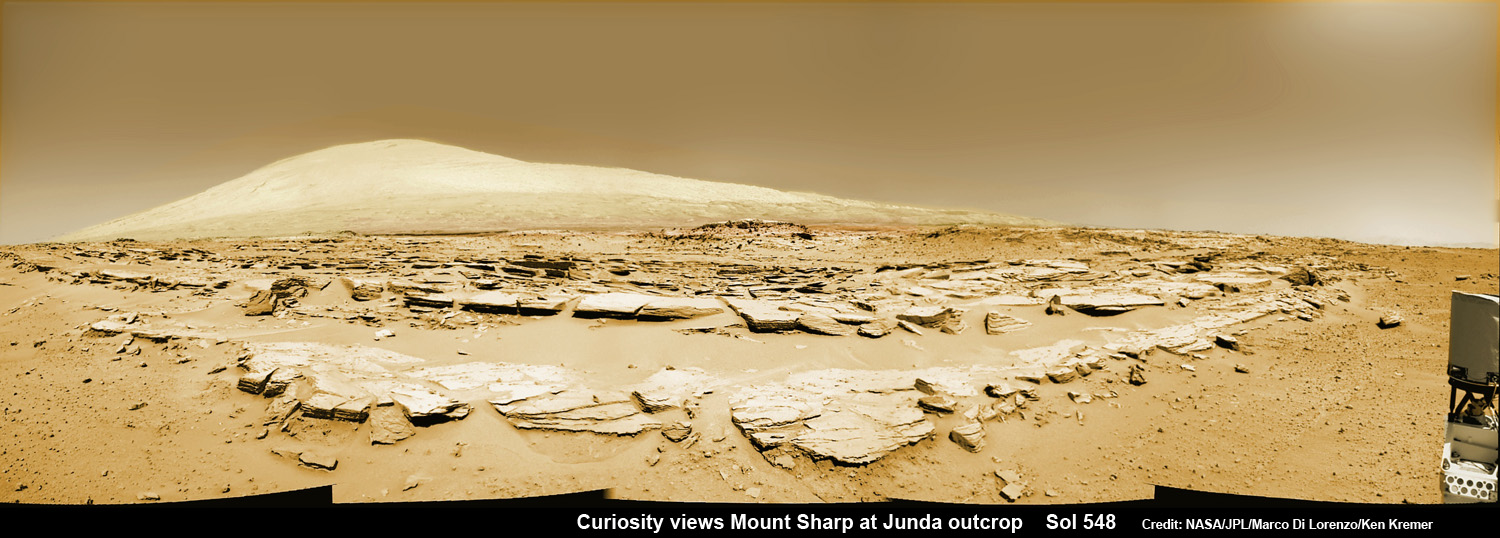
See additional photo mosaics below
NASA’s car sized Curiosity rover has pulled into a tantalizing destination on the Red Planet named “The Kimberley Waypoint” that researchers hope yields a bounty for science at a spot where scientists plan to direct the car sized robot to bore into the subsurface in search of further clues about ancient Martian environments that may have been favorable for life.
For nearly the past year, Curiosity has been on an epic trek since departing from her last big science expedition in the “Yellowknife Bay” region towards her primary goal, the lower reaches of the sedimentary layers of Mount Sharp – because it holds caches of water altered minerals.
“The Kimberley” waypoint lies just over half ways towards Mount Sharp, which reaches 3.4 miles (5.5 km) into the Martian sky inside Gale Crater.
Since arriving in the Kimberley region at the beginning of this month, Curiosity’s earth bound handlers have been carefully moving the 1 ton robot around and analyzing the breathtaking area with her cameras and spectrometers in a meticulous search for the best spot to conduct a drilling operation into the alien rocks that may unlock the Red Planets mysteries dating back eons ago.
Over the past several Martian days or sols, rioer drivers have gradually bumped Curiosity a few yards (meters) at a time ever closer to a spot tentatively selected for drilling.
The chosen drill site is at an outcrop located around the base of a Martian butte named ‘Mount Remarkable’.
Last weekend and continuing up to today, April 23, 2014 (Sol 609) the robot was commanded to capture additional high resolution ChemCam observations and Mastcam images for the teams strategic planners to evaluate in characterizing and pinpointing the most scientifically compelling drill target.
“The tactical team planned lots of ChemCam and Mastcam observations of the candidates,” wrote team member Ken Herkenhoff in a new mission update on Sol 608.
“Later in the day, the rover planners and scientists discussed the drill options, and selected a flat outcrop about 4 meters away.”
Mount Remarkable stands about 16 feet (5 meters) tall.
“After ChemCam observations of targets Jarrad and Cow Bore, the rover will take another set of MAHLI images of the wheels, then bump a couple meters to get into position for contact science and drilling,” he noted.
Kimberley is informally named after a remote region of western Australia.

The majestic terrain is illustrated above in a mosaic of navigation camera images assembled and colorized by the image processing team of Marco Di Lorenzo and Ken Kremer.
Along the recent dune filled path to ‘The Kimberley’, Curiosity snapped breathtaking landscapes around the irresistible ‘Junda’ outcrop, much like a tourist. See our mosaics above and below.
Kimberley was chosen as a science waypoint on the road to Mount Sharp because it lies at the intersection of four different types of rocks, including striated rocks overlain by others and deposited in a decipherable geological relationship to each other, says NASA.
High resolution imagery and mineral mapping spectrometry gathered by NASA’s powerful telescopic HiRISE and CRISM cameras aboard the Mars Reconnaissance Orbiter (MRO) circling overhead piqued researchers interest.
“This is the spot on the map we’ve been headed for, on a little rise that gives us a great view for context imaging of the outcrops at the Kimberley,” said Melissa Rice, Curiosity science planning lead, of Caltech.

Curiosity will likely investigate Kimberley for several weeks of observations into May, including sample-drilling and onboard laboratory analysis of the area’s rocks with the CheMin and SAM miniaturized chemistry labs.
Kimberley will constitute the site of Curiosity’s first drilling operation since boring into the ‘John Klein’ and ‘Cumberland’ outcrop targets at the Yellowknife Bay basin during Spring 2013 where she discovered a habitable zone and thereby accomplished the primary goal of the mission.
.
In anticipation of the drilling campaign into pristine, new Martian rocks, the robot was instructed to clean out SAM, CheMin and the CHIMRA sample handling mechanism before delivering powdery, pulverized samples of the Red Planet to the state-of-the-art instruments.

To date, Curiosity’s odometer totals 3.8 miles (6.1 kilometers) since landing inside Gale Crater on Mars in August 2012.
The six wheeled robot has some 4 kilometers to go to reach the base of Mount Sharp.
She has snapped over 142,000 images as of today.
Curiosity should arrive at the foothills of Mount Sharp sometime in the latter half of 2014, but must first survive the unavoidable passage through a potentially treacherous dune field.
Meanwhile NASA’s Opportunity rover continues exploring Solander Point mountain on the opposite side of Mars.
And the new MAVEN and MOM orbiters from NASA and India are streaking towards the Red Planet for orbital insertion in September 2014.
Stay tuned here for continuing updates.
Missions » MAVEN »



The Curiosity mission is nothing short of spectacular. The images in this article underscore humanity’s search for answers to age-old questions about our place in the Universe. I am always amazed by the pictures telling us, “That’s what Mars looks like!” As if we are standing there right now! Those of us old enough to remember Mariner 4’s close-ups in 1964 could only imagine that one day such amazing missions and discoveries would be part of our expanding knowledge of the Red Planet.
Tom,
thank you for the kind words and excellent comment.